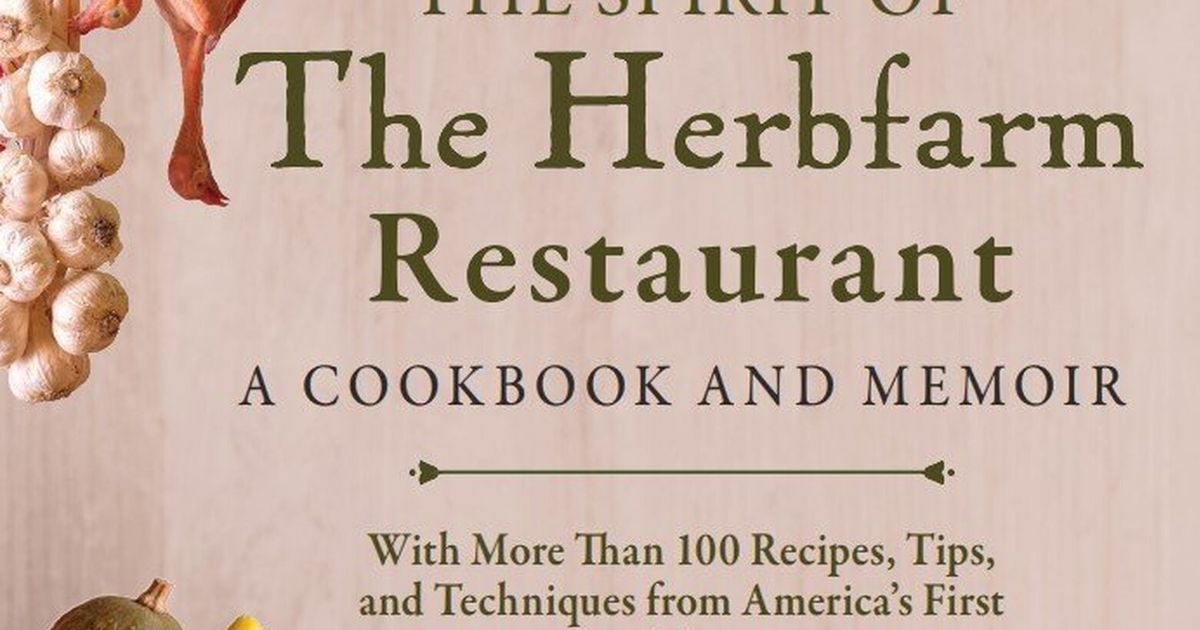THE HERBFARM began in a garage on a real herb farm 25 miles east of Seattle. Ron Zimmerman’s parents owned land in Fall City, and after he and Carrie Van Dyck married there in 1986, they opened a restaurant of sorts: lunch only, three times a week, using the farm’s namesake herbs and exclusively local foods.
Those lunches began with a Van Dyck-led tour of whatever was being grown, and The Herbfarm evolved into a world-renowned destination for local, seasonal excellence. Along the way there was a literal trial by fire, a few years of wandering and a new venue, but what never changed was the commitment to the best of the fields, forests and seas of the Pacific Northwest.
Today, Zimmerman is considered the founder of the farm-to-table movement with The Herbfarm, with credit coming from top culinary luminaries. He and Van Dyck ran the restaurant, with four other chefs eventually heading the kitchen until they sold it in 2021 with big retirement plans.
Zimmerman died of liver cancer in April 2023. Thanks to Van Dyck’s efforts and the help of numerous long-time friends, his posthumously published “The Spirit of The Herbfarm Restaurant: A Cookbook and Memoir” is now being published.
Here, Van Dyck talks about the book, her grieving process, zucchini flowers and more. (This interview has been shortened.)
Bethany Jean Clement: Congratulations on the book – how did it come about?
Carrie Van Dyck: Ron had essentially written the book until 1990 and ultimately never published it for various reasons. But over the years he kept saying that he would have liked to have finished it. And he had the printed copy, and it kept moving from desk to desk…
When he was diagnosed with cancer, I reminded him that he hadn’t finished the book yet and that this was the perfect time to put it together. When he died, he had essentially finished everything, (but) he didn’t have the time to actually refine it the way he would have. He might have added more recipes if he’d had more time, but it was a good, evenly spaced seasonal thing.
The blurbs on the book’s jacket include incredible praise from Thomas Keller: “Years before I first saw The French Laundry, Ron Zimmerman was showing people how to eat seasonally and locally… (and) helped spark something of a revolution in fine dining.” Then René Redzepi points to Ron’s “genius and forward thinking” and says that the restaurant you and Ron built together “is nothing short of iconic and legendary.”
It’s pretty cool. (laughs) I’m very honored to have that on the back. And Ron would have just died and gone to heaven. Well, he died – I don’t know if he went to heaven. (laughs) Anyway, I think he would have been happy with the whole project.
It sounds like you were able to appreciate the precision with which Ron tackled things. It’s a beautiful volume and you can feel the thought that went into it. The two ribbon bookmarks in different colors so the reader can save two different places; the heavy cream paper; and then there are the delicious photos of the food and the beautiful ones of you and Ron. Is there anything about the book that makes you happiest?
I think we did it to the best of our ability the way Ron would have done it. There are certainly some things I think he would have done differently, but my way was always better. (laughs) I think I added nice details to the book that he might not have done on his own.
I promised him that if he didn’t have time to finish the book, I would publish it so he had no excuse. And I’ve gotten so much feedback from people thanking me for putting his words on paper and keeping them alive forever.
It’s only been a year since Ron’s death… Can I ask if you’d like to talk about working on the book and your grieving process?
When Ron died, he was cremated in water, which is supposedly the most environmentally friendly way to do it. (Then) he was packed up in lots of little packages. We were actually planning to travel the world when we retired, but that didn’t happen. So he was given away in little pieces to some of his closest friends, who took him around the world and left little pieces of him here and there. So that’s one of the things I’ve been doing over the past year as part of my grieving process.
I just got back from Portugal. He died just after my 70th birthday. We had this big plan for the celebration that we kept having to change and make smaller. And then he actually couldn’t come. So basically he left the conscious world on my 70th birthday and died a few days later. So I decided that I didn’t need to be here (on my first anniversary) and I needed to be totally immersed in something else to distract myself. And so I cycled through Lisbon to the south coast.
I’ve always ridden a bike, but never more than 5 or 8 miles at a time. Riding 40 miles in one day was an interesting process and fun. It was great. And I’m going to go to New Zealand and a few places in the United States and Canada and probably Argentina. I still have a lot of places to go – a lot of places in Africa that I want to see. I haven’t been to Antarctica yet.
Wonderful. Do you have a favorite part of the book?
One of the last things he finished that was very important to him was the section on the 100-mile dinner, which is kind of the epitome of what The Herbfarm has always tried to do. We had a lot of themes for our dinners at the farm, and one of them in the middle of summer was the 100-mile menu – everything, every ingredient, had to come from (within) 100 miles or less. He brewed beers to go with the menu… One year we had our own vineyard and made wine up on Hollywood Hill, and that was a 1-mile wine – pretty exciting.
In the book, he also included the nutritional guidelines that he created in 1986 when we first came to visit his parents at The Herbfarm, and those guidelines are still followed (in the restaurant) today. So it’s quite profound and I think it’s important, intuitive and innovative at the same time. And when he wrote the memoir – there’s a lot of humor in his writing style.
Regarding the stuffed zucchini flowers recipe shared here, Ron points out that back in the early days of The Herbfarm, he grew a huge zucchini patch just for the flowers.
We actually did that for many years. If you let zucchini grow big, they don’t produce flowers. So we were always giving away and inventing new zucchini recipes. The whole process involves harvesting zucchini every day, even if you’re not going to use it.
So much zucchini. I can’t even imagine it.
Exactly – it was probably about half an acre of zucchini. You always have to wear long pants and long sleeves because when you go through them, it’s quite prickly. So in the height of summer, it can be quite a hot, uncomfortable process.
But it’s worth it, right?
It was great.
Zucchini flowers with zucchini filling and marinated tomatoes
— From “The Spirit of the Herbfarm Restaurant” by Ron Zimmerman
For 4–8 people
For the zucchini:
8 zucchini flowers, female, with the baby zucchini attached, pistil inside the flower removed
For the zucchini filling:
2 zucchini, medium, sliced (2 cups)
¾ cup extra virgin olive oil, divided
1 shallot, large, chopped
3 garlic cloves, chopped
3 tablespoons thyme, fresh, leaves from the stem
5 tablespoons basil leaves, chopped
¾ cup breadcrumbs
Salt and pepper to taste
For the marinated tomatoes:
2 cups tomatoes, peeled, seeded and diced
3 garlic cloves, chopped
2 shallots, chopped
½ cup balsamic vinegar
½ cup extra virgin olive oil
¼ cup basil leaves, finely chopped
Salt and pepper to taste
For the zucchini filling:
1. Cut the zucchini into slices. Heat a pan, add a tablespoon of olive oil and sauté the zucchini until soft. Add the shallot and garlic. Cook for 2 minutes.
2. Add thyme leaves. Cook until zucchini is soft.
3. Place in a food processor with basil, breadcrumbs and remaining olive oil. Process until smooth. Add more oil or breadcrumbs if necessary until mixture almost holds together. Season with salt and pepper to taste.
Preparation of the marinated tomatoes:
1. Cook tomatoes, garlic and shallots in a medium skillet until most of the liquid has evaporated. Remove from heat.
2. In a medium bowl, combine vinegar, olive oil and basil. Add the cooked tomato mixture. Season with salt and pepper to taste. Mix well. Let stand at least 1 hour before serving.
Fill and bake flowers:
Fill the zucchini filling into a piping bag. Pipe the filling into the flowers. Twist the flower tips shut. Brush the flowers lightly with olive oil and place on an oiled baking tray. Bake for 3 minutes at 230 °C.
completion:
Serve the flowers warm on marinated tomatoes.
Serving Variation:
Trim the ends of the zucchini to a point. Make ¼-inch cut lines all the way to the blossom. Fill the blossom ¾ full and twist to seal well. Bake these packets and stand them upright on top of the tomatoes.



